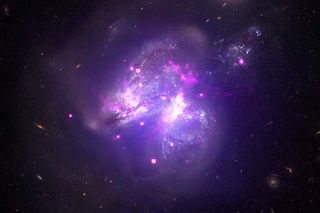Slowly Merging Galaxies Form a Breathtaking 'Galactic Goulash' (Video)
Two colliding galaxies have spent millions of years slowly mixing and mingling their respective stars, resulting in a gorgeous interstellar stew filled with bright X-ray sources.
NASA's Chandra X-ray space telescope captured this stunning new view of the interacting galaxies, collectively named Arp 299, by observing the X-ray radiation emitted by this rich mix of stars.
The telescope spotted an unusually high number of bright X-ray sources in Arp 299. Of the 25 X-ray sources seen in the galactic mix, 14 are categorized as ultraluminous X-ray sources (ULXs) for their exceptionally strong X-ray emissions, NASA officials said in a statement. [When Galaxies Collide: Photos of Great Galactic Crashes]
"These ULXs are found embedded in regions where stars are currently forming at a rapid rate," NASA added. "Most likely, the ULXs are binary systems where a neutron star or black hole is pulling matter away from a companion star," a type of star system known as an X-ray binary.

While galaxies aren't usually packed with so many X-ray binaries, scientists believe that a wave of new star formation in Arp 299 is responsible for this abnormally dense population of these bright X-ray sources.
The galactic merger that created Arp 299 also triggered a baby boom of stars as clouds of interstellar gas and dust from the original two galaxies collided. "The formation of high-mass X-ray binaries is a natural consequence of such blossoming star birth as some of the young massive stars, which often form in pairs, evolve into these systems," NASA officials said.
Get the Space.com Newsletter
Breaking space news, the latest updates on rocket launches, skywatching events and more!
To create this stunning, multicolor view of Arp 299, NASA combined data from the Chandra X-ray telescope with even higher-energy X-ray observations by NASA's Nuclear Spectroscopic Telescope Array (NuSTAR) and visible-light observations by the Hubble Space Telescope.
The image was released on June 26, and astronomers detailed their observations in the Aug. 21, 2016, issue of the Monthly Notices of the Royal Astronomical Society.
Email Hanneke Weitering at hweitering@space.com or follow her @hannekescience. Follow us @Spacedotcom, Facebook and Google+. Original article on Space.com.
Join our Space Forums to keep talking space on the latest missions, night sky and more! And if you have a news tip, correction or comment, let us know at: community@space.com.

Hanneke Weitering is a multimedia journalist in the Pacific Northwest reporting on the future of aviation at FutureFlight.aero and Aviation International News and was previously the Editor for Spaceflight and Astronomy news here at Space.com. As an editor with over 10 years of experience in science journalism she has previously written for Scholastic Classroom Magazines, MedPage Today and The Joint Institute for Computational Sciences at Oak Ridge National Laboratory. After studying physics at the University of Tennessee in her hometown of Knoxville, she earned her graduate degree in Science, Health and Environmental Reporting (SHERP) from New York University. Hanneke joined the Space.com team in 2016 as a staff writer and producer, covering topics including spaceflight and astronomy. She currently lives in Seattle, home of the Space Needle, with her cat and two snakes. In her spare time, Hanneke enjoys exploring the Rocky Mountains, basking in nature and looking for dark skies to gaze at the cosmos.
